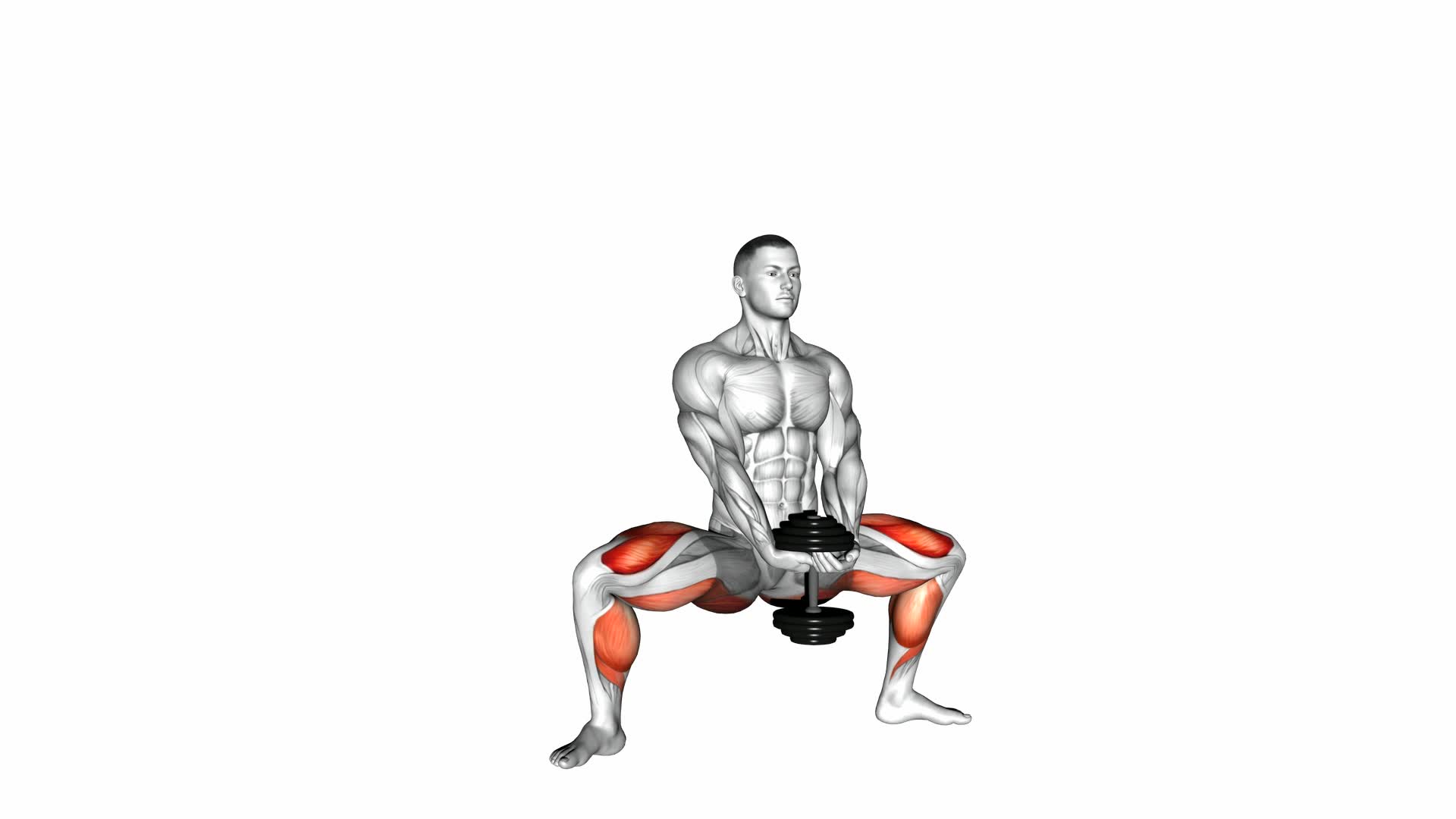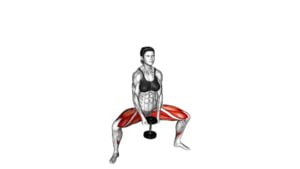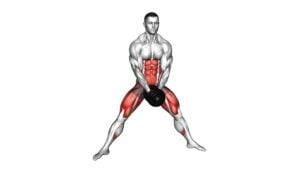Dumbbell Plyo Squat – Video Exercise Guide & Tips

Looking to take your leg workout to the next level? Try the Dumbbell Plyo Squat! This explosive exercise targets your glutes, quads, and hamstrings, giving you a powerful lower body.
Watch This Exercise Video
In this video exercise guide, we'll show you the proper form and technique, along with modifications for different fitness levels. Avoid common mistakes and maximize your workout with our expert tips.
Get ready to feel the burn and see results with the Dumbbell Plyo Squat!
Key Takeaways
- Targets glutes, quads, and hamstrings
- Enhances athletic performance and overall fitness level
- Activates fast-twitch muscle fibers for more power and speed
- Improves explosive power essential for sprinting, jumping, and changing directions rapidly
Benefits of the Dumbbell Plyo Squat
Experience explosive power and increased lower body strength with the dumbbell plyo squat. Incorporating plyometrics into your routine can greatly enhance your athletic performance and overall fitness level. Plyometric exercises, such as the dumbbell plyo squat, involve quick and explosive movements that activate the fast-twitch muscle fibers in your legs, allowing you to generate more power and speed.
By performing the dumbbell plyo squat, you'll improve your explosive power, which is essential for activities like sprinting, jumping, and changing directions rapidly. This exercise targets your quadriceps, hamstrings, glutes, and calves, helping you develop stronger and more defined leg muscles. Additionally, the added resistance of dumbbells increases the challenge and stimulates muscle growth.
To perform the dumbbell plyo squat, start by holding a pair of dumbbells at your sides, with your feet shoulder-width apart. Lower yourself into a squat position, keeping your chest up and your knees in line with your toes. Explosively push off the ground, jumping as high as you can while raising your arms overhead. Land softly and immediately transition into the next repetition.
Incorporating the dumbbell plyo squat into your training routine can provide significant benefits, improving your explosive power and lower body strength. Remember to start with lighter weights and gradually increase the load as your strength and technique improve.
Proper Form and Technique
To perform the dumbbell plyo squat with proper form and technique, you should start by ensuring your feet are shoulder-width apart and holding a pair of dumbbells at your sides. This exercise offers several benefits when done correctly. First, it targets multiple muscle groups, including your quadriceps, hamstrings, glutes, and calves, making it an effective lower body workout. Additionally, the explosive nature of the exercise helps improve power and athleticism.
To maximize the benefits of proper form, it's important to avoid common mistakes. One common mistake isn't maintaining proper alignment. Make sure your knees are tracking in line with your toes, and your back is straight throughout the movement. Another mistake isn't going deep enough into the squat. Aim to lower your hips until your thighs are parallel to the ground, or even slightly below if you can. Finally, avoid using excessive weight that compromises your form. It's better to start with lighter weights and gradually increase as you become more comfortable with the exercise.
Equipment Needed for the Exercise
To perform the dumbbell plyo squat with proper form and technique, you'll need a pair of dumbbells. The dumbbells add resistance to the exercise, helping to strengthen and tone your leg muscles. They also increase the intensity of the workout, making it more challenging and effective. Using dumbbells during the plyo squat engages your upper body as well, promoting overall muscle development.
When choosing dumbbells for this exercise, it's important to select a weight that challenges you but still allows you to maintain proper form. Start with lighter dumbbells and gradually increase the weight as you become stronger and more comfortable with the exercise.
The benefits of using dumbbells for the plyo squat are numerous. They help to build lower body strength, improve balance and stability, and increase power and explosiveness in your movements. Additionally, incorporating dumbbells into your workout routine can help to increase calorie burn and promote weight loss.
Now that you know the equipment needed for the dumbbell plyo squat, let's move on to discussing modifications for different fitness levels.
Modifications for Different Fitness Levels
To modify the dumbbell plyo squat for different fitness levels, there are a few adjustments you can make.
If you're just starting out or have limited mobility, you can begin by performing the exercise without dumbbells or by using lighter weights.
As you progress and become more comfortable, you can increase the weight or add explosive jumps to intensify the workout.
Remember to always listen to your body and choose modifications that challenge you without causing pain or discomfort.
Scaling Workout Intensity
If you want to modify the workout intensity based on your fitness level, you can make adjustments using different scaling techniques. Here are four ways to modify your workout and increase the difficulty:
- Increase the weight: If you find the exercise too easy, try using heavier dumbbells to challenge yourself more.
- Increase the speed: Performing the exercise at a faster pace can increase the intensity and make it more challenging.
- Add plyometric movements: Incorporating explosive movements like jump squats can make the exercise more dynamic and demanding.
- Decrease rest time: Instead of taking long breaks between sets, try reducing the rest time to keep your heart rate up and increase the overall intensity of the workout.
Adapting for Beginners
To adapt the workout for beginners and individuals of different fitness levels, it's important to consider modifications that can cater to their specific needs and abilities.
For beginners, it's recommended to start with bodyweight squats before adding dumbbells. This allows them to focus on proper form and technique without the added weight. As they progress, beginners can gradually incorporate lighter dumbbells to build strength.
It's also important for beginners to listen to their bodies and take breaks when needed. Remember to start with a weight that feels manageable and gradually increase the intensity as you get stronger. By gradually increasing the weight and intensity, beginners can safely progress and avoid injuries.
Transitioning into the subsequent section about 'common mistakes to avoid', it's crucial to pay attention to form and avoid rushing through the exercise.
Common Mistakes to Avoid
To avoid common mistakes during the dumbbell plyo squat, it's important to pay attention to your form. Incorrect form can lead to potential dangers and increase the risk of injury.
Incorrect Form Dangers
Avoiding incorrect form is crucial to prevent potential dangers and maximize the benefits of the dumbbell plyo squat exercise. Proper technique is essential for avoiding injuries and getting the most out of your workout.
Here are some common mistakes to avoid when performing the dumbbell plyo squat:
- Rounded back: Maintaining a neutral spine is important to prevent strain on your lower back.
- Knee collapse: Be careful not to let your knees cave inwards during the squat, as this can put excessive stress on the knee joints.
- Improper landing: When jumping back up from the squat, land softly with your knees slightly bent to protect your joints.
- Lack of control: It's important to maintain control throughout the exercise to avoid injury and maximize the effectiveness of the movement.
Preventing Injury Through Correction
Correcting common mistakes is essential for preventing injury and maximizing the benefits of the dumbbell plyo squat exercise. To prevent injury, it's important to focus on proper form and technique. One common mistake to avoid is allowing your knees to cave inwards during the squat. This can put excessive strain on your knees and increase the risk of injury. Instead, make sure to keep your knees aligned with your toes throughout the movement.
Another mistake is using too much weight. It's crucial to start with a weight that you can comfortably handle and gradually increase the intensity as your strength improves.
Lastly, avoid rushing through the exercise. Taking the time to perform each repetition with control and precision will help prevent injury and ensure optimal results.
Incorporating corrective exercises, such as strengthening the muscles around the knees and hips, can also help prevent injuries and improve overall performance.
Tips for Getting the Most Out of Your Workout
Maximize your workout results by incorporating these 5 key tips:
- Set Clear Goals: Before starting your workout, set specific and achievable goals. This will help you stay focused and motivated throughout your workout session. Whether you want to increase strength, improve endurance, or lose weight, having a clear objective will allow you to optimize your workout effectiveness.
- Warm Up Properly: A proper warm-up is essential to maximize your results and prevent injuries. Start with some light cardio exercises to increase your heart rate and warm up your muscles. Follow it up with dynamic stretches to improve flexibility and mobility. This will prepare your body for the main workout and enhance your performance.
- Vary Your Routine: To keep your body challenged and avoid hitting a plateau, it's important to vary your workout routine. Incorporate different exercises, change the number of sets and repetitions, and try new equipment or workout classes. This will keep your muscles guessing and optimize your workout effectiveness.
- Fuel Your Body: Proper nutrition is key to maximizing your results. Make sure you're consuming a balanced diet that includes lean proteins, complex carbohydrates, and healthy fats. Stay hydrated before, during, and after your workout to maintain optimal performance and aid in muscle recovery.
Frequently Asked Questions
How Many Calories Can I Expect to Burn by Doing the Dumbbell Plyo Squat?
You can expect to burn a significant number of calories by incorporating plyometric exercises like the dumbbell plyo squat into your workout routine. Plyometric exercises are known for their ability to increase heart rate and boost metabolism, resulting in a higher calorie burn.
The intensity and duration of your workout will determine the exact number of calories burned. Remember to maintain proper form and gradually increase the weight and intensity for maximum results.
Can the Dumbbell Plyo Squat Help Me Increase My Vertical Jump?
The dumbbell plyo squat can definitely help you increase your vertical jump. By incorporating explosive movements and plyometric exercises, this exercise targets the muscles in your legs and hips, which are crucial for jumping power.
To properly perform the dumbbell plyo squat, start with your feet shoulder-width apart, holding dumbbells at your sides. Lower into a squat position, then explode upwards, jumping as high as you can. Land softly and repeat.
The benefits of this exercise include improved leg strength, power, and vertical jump height.
Is the Dumbbell Plyo Squat Suitable for People With Knee Problems?
If you have knee problems, the dumbbell plyo squat may not be suitable for you. It's important to prioritize your safety and avoid exercises that could potentially worsen your condition.
However, there are modifications you can make to the exercise to reduce the strain on your knees. If you're looking to improve overall leg strength, there are other exercises that can provide similar benefits without putting excessive stress on your knees.
Can I Incorporate the Dumbbell Plyo Squat Into My Regular Leg Day Workout Routine?
Yes, you can definitely incorporate the dumbbell plyo squat into your regular leg day workout routine. It's a great exercise that targets your legs, glutes, and core.
However, if you have knee problems, it's important to modify the exercise to avoid any discomfort or further injury. You can try using lighter weights or performing the exercise without the plyometric jump.
Remember to listen to your body and consult with a fitness professional if needed.
How Long Should I Rest Between Sets When Performing the Dumbbell Plyo Squat?
When performing the dumbbell plyo squat, it's important to consider your rest time between sets. Resting for about 1-2 minutes is recommended to allow your muscles to recover and maintain proper form throughout the exercise.
This rest time will give you enough recovery without letting your heart rate drop too much. Remember to focus on maintaining good form and explosiveness during each repetition to maximize the benefits of this exercise.
Conclusion
In conclusion, the dumbbell plyo squat is a highly effective exercise that offers numerous benefits for your lower body strength and power.
By following proper form and technique, using the appropriate equipment, and making modifications based on your fitness level, you can maximize the effectiveness of this exercise.
Avoiding common mistakes and implementing helpful tips will help you get the most out of your workout and achieve your fitness goals.

Author
Years ago, the spark of my life’s passion ignited in my mind the moment I stepped into the local gym for the first time. The inaugural bead of perspiration, the initial endeavor, the very first surge of endorphins, and a sense of pride that washed over me post-workout marked the beginning of my deep-seated interest in strength sports, fitness, and sports nutrition. This very curiosity blossomed rapidly into a profound fascination, propelling me to earn a Master’s degree in Physical Education from the Academy of Physical Education in Krakow, followed by a Sports Manager diploma from the Jagiellonian University. My journey of growth led me to gain more specialized qualifications, such as being a certified personal trainer with a focus on sports dietetics, a lifeguard, and an instructor for wellness and corrective gymnastics. Theoretical knowledge paired seamlessly with practical experience, reinforcing my belief that the transformation of individuals under my guidance was also a reflection of my personal growth. This belief holds true even today. Each day, I strive to push the boundaries and explore new realms. These realms gently elevate me to greater heights. The unique combination of passion for my field and the continuous quest for growth fuels my drive to break new ground.







